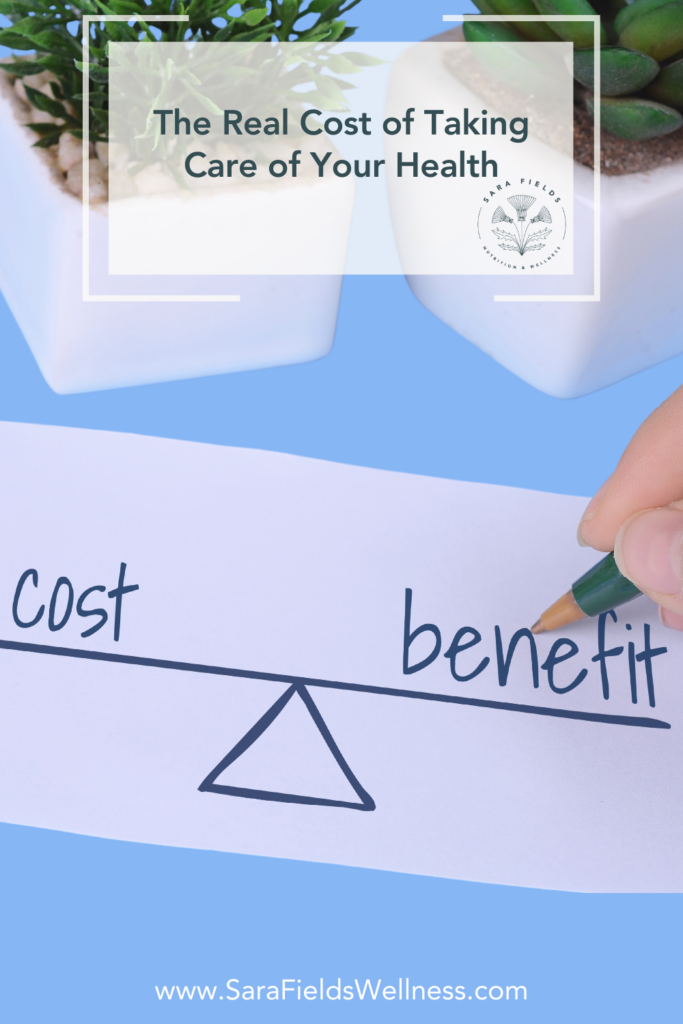
Let’s talk about money (and a lot of other things).
It’s the number one reason I hear why people opt not to work with our team or other health and wellness providers that operate outside the standard model.
I totally get it and have had the same objections myself.
This world is so expensive to inhabit these days.
It can feel selfish or uncomfortable to invest in ourselves, especially if there are needs of a family to consider.
Committing to a long-term health strategy can feel overwhelming, like it’ll take too long, or it can bring up fears of failure – all of which can make NOT investing in ourselves seem like the better, safer option.
Complementing these things is the fact that we’ve become so reliant on our healthcare system and insurance. We’re used to paying co-pays and only pursuing treatments or tests that are covered. To pay out of pocket for these things – it’s foreign.
And, quite frankly, it’s maddening that comprehensive wellness care — nutrition, exercise, and root-cause approaches that aim to do more than manage symptoms — is not the foundation of our healthcare system.
Because it’s not, so many of us are left having to seek out care outside of the system.
We find ourselves stuck in this place of choosing between spending money or settling for what’s available… while often doing our own research on the side to understand why we have chronic fatigue, acne, eczema, IBS, or an autoimmune thyroid disease that has made day to day living so challenging.
Before I get much further, let me just state for the record that I’m not anti-conventional medicine or prescription drugs. Those things are needed. I’m grateful for them.
But the two truths can exist at the same time. And there is a massive gap here.
Which brings me back to money. This pesky human invention that is so damn limiting.
Why’s it gotta be so expensive to be well?
But this is where we are, friends. It’s what we’re working with.
So given this, the question I would encourage you to ask instead is, how much is it actually costing us to not invest in our health?
I could throw in a million stats about the national debt, healthcare expenses, and the societal cost of our declining health, but that’s not my point.
My point is much more focused on the personal costs.
There’s the financial impact – the price you pay in lost time, lost energy, and even lost income. Sick days you’ve taken, the opportunities you’ve passed up because you didn’t have the energy or even the promotion you didn’t feel well enough or confident enough to go after.
And then there’s the emotional cost. Canceled plans because you were too drained. Snapping at your kids or spouse, not because you were upset, but because you were physically and mentally exhausted. Your relationships suffer and your passions get sidelined.
We’re all too familiar with these costs – we’ve paid them too.
What is it costing you?
While most of this conversation really is about mindset and rethinking how we view the cost of our health, there are also some tangible ways to make investing in yourself not feel quite so difficult. For example, Fullscript and some other supplement companies now accept FSA/HSA for supplement purchases. Some providers, including us, are willing to set up payment plans. You can ask for health and wellness services as a birthday or holiday gift from loved ones. Often, you just have to get creative.
So the bottom line is this: for many of us, the cost of not addressing our health is far greater than the cost of investing in the solution.
I realize that what I’ve said here might sound like a money grab or seem self-serving — yes, working with people is how I make a living. But it’s also what I believe is necessary to make the world a better place. For all of us. A ripple effect.
Wellness for all, one person at a time.
A Note of Acknowledgment
I want to take a moment to acknowledge that not everyone has the luxury of affording this kind of work. It’s not always just a mindset shift or getting creative with payment options — for some, the resources truly are not there, no matter how much they want to invest in their health. This article is not meant to shame or criticize anyone in that situation.
This message is directed at those who do have the resources but may be hesitant to prioritize their health due to other factors. I see you and recognize that everyone’s circumstances are different. My goal here is to help those who currently can make this investment, but haven’t yet, reframe the way they think about the true cost of their health.
My hope is to continue exploring options that are accessible to more people. We currently offer tiers of service to account for different financial situations, but we’re always looking for ways to expand our reach and transcend those limitations.

leave a comment